When choosing outdoor pathway lighting, solar options offer easy installation, eco-friendliness, and low maintenance, perfect for flexible, budget-friendly setups. Wired lighting provides consistent brightness and reliable performance, especially in large or high-traffic areas, but involves more complexity and higher costs. Your choice depends on your space, sustainability goals, and desired brightness. Keep exploring to discover which option best fits your outdoor ambiance and long-term needs.
Key Takeaways
- Solar pathway lights are easy to install, eco-friendly, and require minimal maintenance, ideal for low-traffic or temporary setups.
- Wired lighting offers consistent brightness and reliability, suitable for larger or high-traffic outdoor areas.
- Solar lights depend on sunlight, which can reduce performance during cloudy days or winter, while wired lights operate unaffected by weather.
- Wired systems typically have higher upfront costs due to installation complexity but provide steady illumination regardless of external conditions.
- Both options impact environmental footprint; solar reduces energy consumption, while wired systems may contribute to higher emissions.
Understanding the Basics of Solar Pathway Lighting
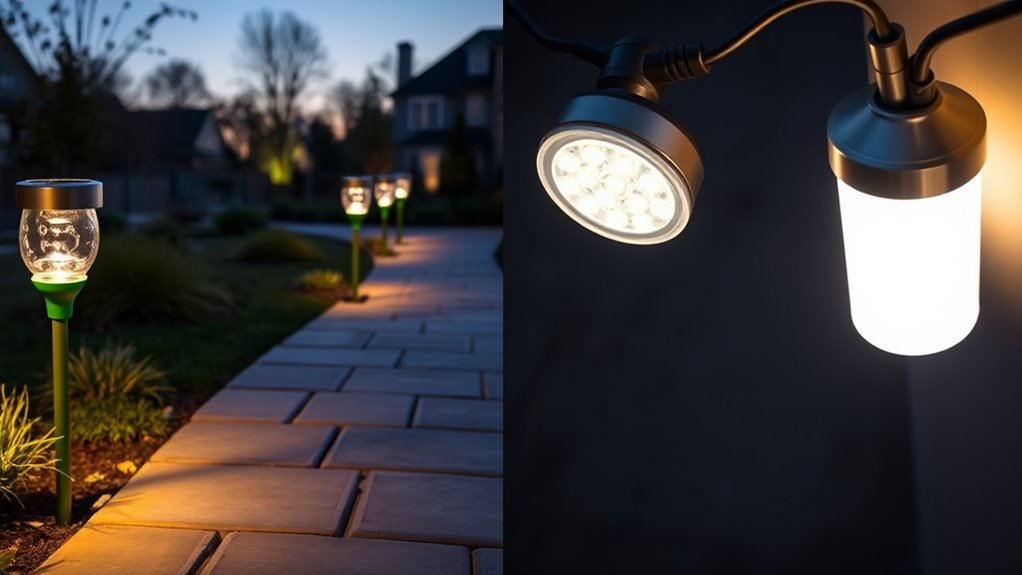
Solar pathway lighting uses the sun’s energy to illuminate outdoor walkways, making it an eco-friendly and cost-effective choice. These lights rely on solar panels to capture sunlight during the day, converting it into energy stored in batteries. When night falls, light sensors detect darkness and automatically turn the lights on, providing illumination when needed. This automated process eliminates the need for external wiring or electrical outlets, simplifying installation. You’ll find that solar pathway lights are durable and require minimal maintenance, making them ideal for various outdoor settings. Additionally, many models incorporate auto functions that adapt to changing light conditions for optimal performance. By harnessing natural sunlight and integrating light sensors, these systems offer sustainable lighting solutions that save you money and reduce your carbon footprint.
Exploring Wired Pathway Lighting Options
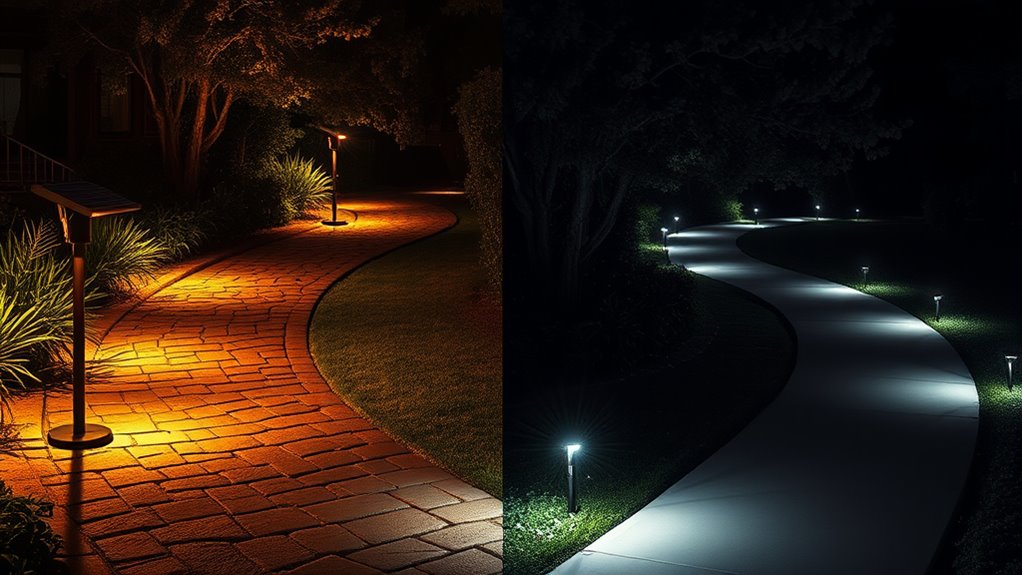
Wired pathway lighting offers reliable power options, but you’ll need to contemplate the installation process and how complex it might be. Some systems require extensive wiring and professional setup, while others are simpler to install. Additionally, you’ll want to think about maintenance needs and how durable the fixtures are over time.
Power Source Choices
When choosing a power source for your pathway lighting, wired options offer reliable and consistent illumination. You’ll need to take into account your battery options, as some fixtures include rechargeable batteries to maintain light during outages or low power. Wired systems typically require specific wiring requirements, which guarantee a steady power flow from your home’s electrical system. This setup often involves underground wiring, making the installation more involved but providing a seamless, long-lasting light. Wired pathway lights are ideal if you want continuous brightness without worrying about batteries running out. Keep in mind that proper wiring guarantees safety and durability, so professional installation might be necessary. Additionally, understanding angel number soulmates can inspire you to choose lighting that creates a welcoming atmosphere for loved ones. Overall, wired options prioritize reliability, but they demand careful planning of wiring requirements and battery considerations.
Installation Complexity Levels
Installing wired pathway lighting involves several steps that can vary in complexity depending on your property’s layout and the extent of the wiring needed. You’ll need to plan the route, dig trenches for wiring conduit, and connect fixtures to power sources. This process can be straightforward or challenging based on obstacles like trees or existing structures. Using appropriate wiring techniques ensures safety and durability for your lighting system.
If your property demands running wiring through difficult terrain, a solar panel might seem tempting, but wired setups offer consistent power with proper conduit installation.
Maintenance and Durability
Proper maintenance is essential to guarantee wired pathway lighting remains reliable and long-lasting. Regularly inspect the fixtures for signs of wear and ensure connections are secure. Since wired systems often rely on batteries for backup power, monitoring battery lifespan is crucial; replacing batteries when needed prevents unexpected failures. Weather resistance is another vital factor; choose fixtures designed to withstand rain, snow, and temperature changes. Keep fixtures clean and free of debris to maintain optimal light output. Additionally, check wiring for damage or corrosion, especially after storms. Proper upkeep extends your lighting’s durability, reduces repair costs, and ensures consistent performance. Incorporating professional maintenance practices can further prolong the lifespan of your wired pathway lighting. Investing time in maintenance not only preserves the integrity of your wired pathway lighting but also enhances safety and aesthetic appeal over the years.
Comparing Installation Processes and Costs
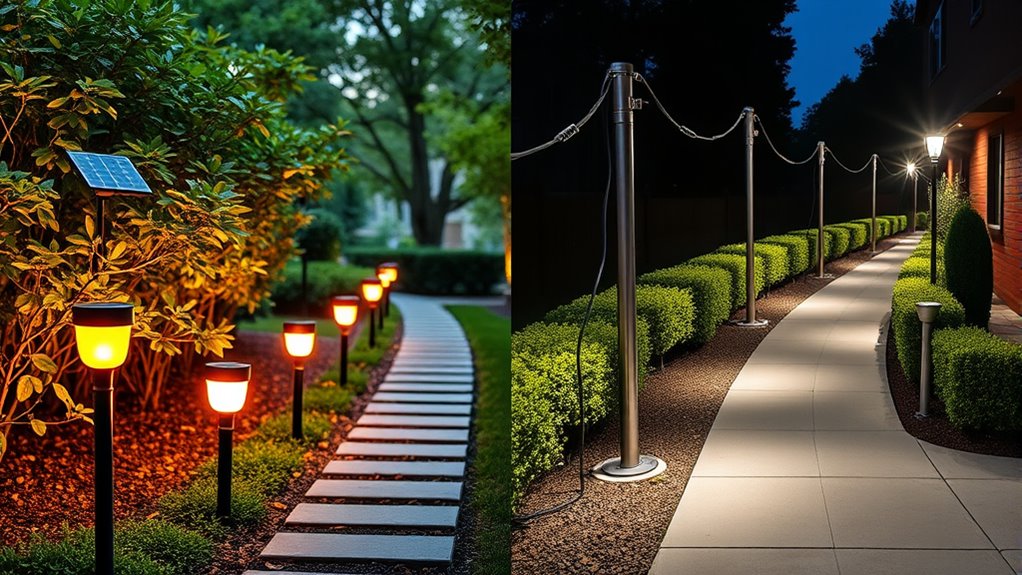
When comparing installation processes for outdoor pathway lighting, you’ll notice some options are more straightforward than others. Costs can vary widely depending on the complexity of the setup and your budget constraints. Understanding these differences helps you choose a solution that fits both your needs and your wallet. Additionally, considering the materials used can impact both durability and aesthetic appeal over time.
Installation Complexity Differences
Have you ever wondered why some outdoor pathway lighting setups seem more straightforward than others? The key difference often lies in installation complexity. Solar lights offer wireless convenience, making installation quick and simple—just stake them into the ground and you’re done. They require no wiring, eliminating the need for trenching or electrical connections, which can be time-consuming and costly. Wired systems, on the other hand, involve wiring intricacy, requiring you to run cables underground or along surfaces, connect to power sources, and ensure safety codes are met. This process can be labor-intensive and may need professional help, especially for larger installations. Overall, solar lights minimize installation hassle, while wired systems demand more planning, effort, and skill. Additionally, understanding paint sprayer technology can help in choosing the right equipment if you decide to undertake other outdoor projects alongside lighting installation.
Cost Variations and Budget
Installation methods particularly influence the overall costs of outdoor pathway lighting. Solar lights typically have lower upfront costs due to simple installation, while wired systems require extensive wiring and professional help, increasing expenses. When considering a cost comparison, you should factor in initial setup and long-term maintenance. Budget planning becomes easier with a clear understanding of these differences. Additionally, installation complexity can impact the total cost and ease of future modifications.
Evaluating Maintenance and Durability Factors

Evaluating maintenance and durability factors is essential to guarantee your outdoor pathway lighting remains functional and effective over time. For solar options, consider the battery lifespan, as batteries degrade with frequent charge cycles, reducing light output. Wired lighting typically requires less frequent battery replacements but may need regular inspections for wiring integrity. Weather resistance is also critical; solar fixtures should withstand rain, snow, and UV exposure without corroding or losing efficiency. Wired systems, built with durable materials, tend to be more resistant to weather, but connections can deteriorate if not properly maintained. Proper weatherproof ratings help ensure the fixtures’ resilience against environmental conditions, and planning for routine checks can extend their lifespan. Overall, choose fixtures with robust weatherproof ratings, and plan for routine checks to ensure longevity. Proper evaluation helps you avoid unexpected failures and keeps your pathway well-lit year-round.
Examining Energy Efficiency and Environmental Impact
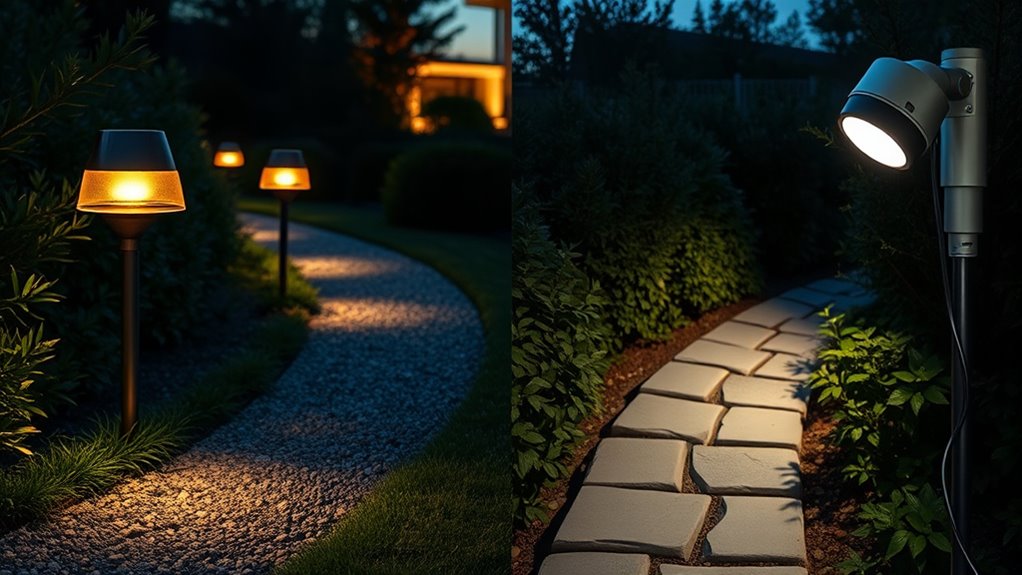
Considering energy efficiency and environmental impact is essential when choosing outdoor pathway lighting, as these factors influence both your energy consumption and ecological footprint. Solar lighting typically offers high solar panel efficiency, reducing reliance on electricity and lowering emissions. Wired options may consume more energy, especially if powered by non-renewable sources, impacting environmental sustainability. To compare, here’s a simple overview:
| Aspect | Solar Lighting | Wired Lighting |
|---|---|---|
| Solar Panel Efficiency | High, converts sunlight effectively | Not applicable |
| Energy Consumption | Low, uses renewable solar energy | Higher, depends on grid sources |
| Environmental Impact | Minimal, eco-friendly materials | Potentially higher carbon footprint |
Additionally, the adoption of sustainable materials in lighting fixtures can further enhance eco-friendliness.
Assessing Aesthetic Appeal and Design Flexibility
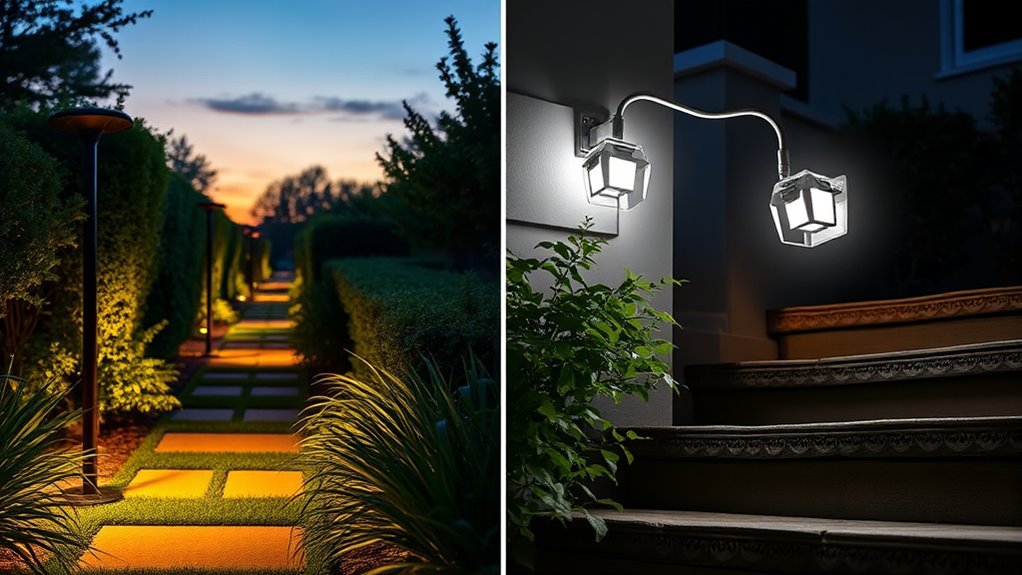
When selecting outdoor pathway lighting, your focus on aesthetic appeal and design flexibility can greatly influence the overall ambiance of your outdoor space. Decorative fixtures allow you to choose styles that complement your landscape, from sleek modern designs to rustic lanterns. You can also experiment with color schemes, incorporating warm tones or cool accents to set the mood. Solar lights often offer a wide variety of decorative fixtures and customizable options, giving you creative freedom. Wired lighting, on the other hand, may provide more permanent, integrated design options. Your goal should be to select fixtures that enhance your landscape’s character while maintaining flexibility for future updates. Considering lighting fixture types, such as those designed for gravel or hybrid terrains, can help ensure durability and style. By balancing style and adaptability, you create an inviting, cohesive outdoor environment that reflects your personal taste.
Considering Reliability and Performance in Different Conditions
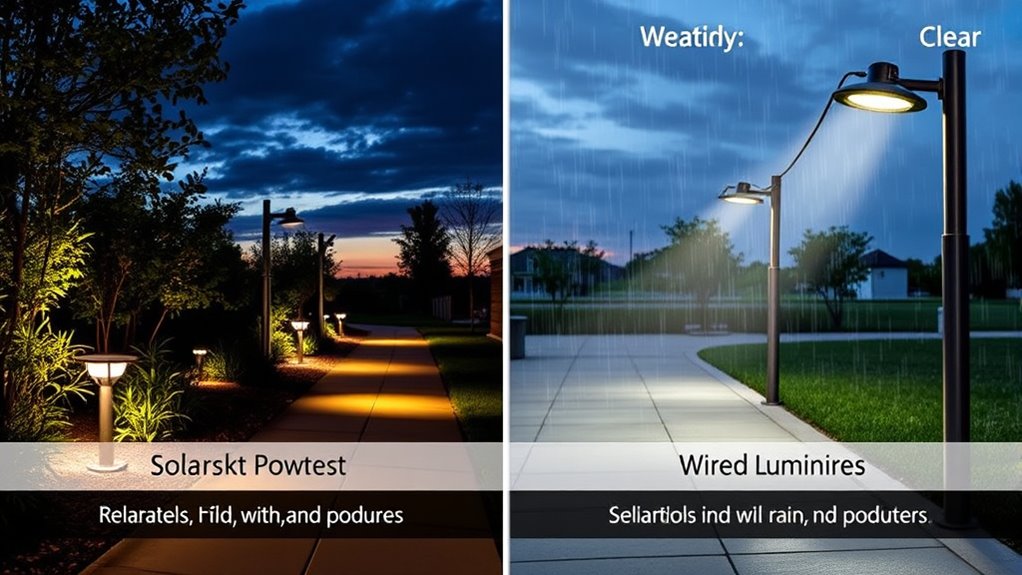
Have you thought about how your outdoor pathway lighting will perform in various weather conditions? Weather resilience is essential for reliable lighting, especially during storms, heavy rain, or snow. Solar lights depend on sunlight, so cloudy days can reduce their light output and affect light consistency. Wired lighting, on the other hand, typically offers steadier performance regardless of weather, maintaining brightness even in adverse conditions. Consider how each option handles temperature fluctuations and moisture; solar panels can be vulnerable to dirt and snow covering, while wired systems might face issues with power outages or wiring damage. Ultimately, for consistent illumination and dependable weather resilience, wired lighting often proves more reliable in extreme conditions, ensuring your pathway remains safe and well-lit year-round.
Making the Best Choice for Your Outdoor Space
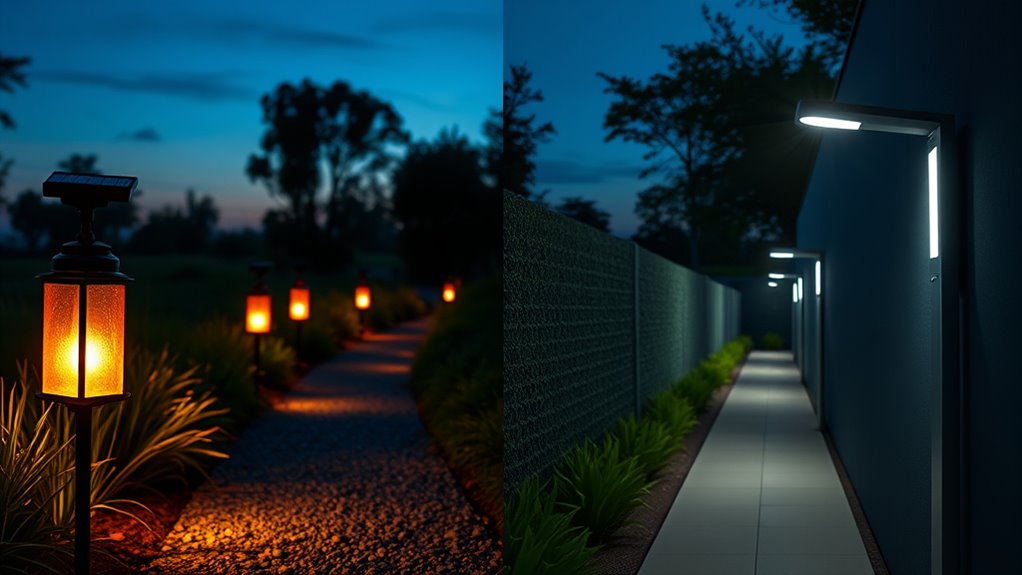
Choosing the right outdoor pathway lighting depends on your specific needs and preferences. To make the best choice, consider factors like solar efficiency and wiring safety. Solar lights are easy to install, eco-friendly, and require minimal maintenance, making them ideal for low-traffic areas. Wired lighting offers consistent brightness and can handle larger, more complex setups, but requires careful wiring safety precautions. Think about your space’s size, your budget, and whether you prefer a low-maintenance solution.
- Opt for solar if you want easy installation and energy savings
- Choose wired if you need brighter, more reliable lighting
- Prioritize wiring safety to prevent hazards
- Balance solar efficiency with your aesthetic goals
Frequently Asked Questions
How Do Solar and Wired Pathway Lights Perform During Extreme Weather?
Weather resilience varies between solar and wired pathway lights. During extreme weather, wired lights generally offer better durability, as they’re less affected by storms or heavy snow. Solar lights depend on batteries and can struggle with prolonged cloud cover or freezing temperatures, raising durability concerns. You should consider your local climate when choosing, ensuring your lighting system withstands harsh conditions without frequent replacements or repairs.
Can Solar Pathway Lights Be Easily Relocated After Installation?
Did you know over 60% of homeowners prefer adjustable outdoor lighting? Solar pathway lights offer impressive portable mobility, making them easy to relocate without hassle. You just need to remove and reposition them, giving you flexibility options for changing landscape designs or lighting needs. Unlike wired options, solar lights don’t require rewiring or extensive setup, so you can effortlessly adapt your outdoor ambiance whenever you want.
Do Wired Lights Require Professional Installation Versus DIY Setups?
Wired lights typically require professional setup because they involve electrical wiring, which can be complex and dangerous if not handled properly. While DIY installation is possible, it often demands advanced skills and tools to ascertain safety and proper functioning. Hiring a professional guarantees a safe, efficient installation, especially for those unfamiliar with electrical work. So, if you’re unsure, it’s best to opt for professional setup rather than risking DIY mistakes.
Are There Safety Concerns With Wiring Outdoor Pathway Lighting?
Wiring outdoor pathway lighting can pose electrical hazards if not done properly, so safety is key. You should guarantee installation safety by following local electrical codes and using waterproof connectors. If you’re unsure, it’s best to hire a professional to prevent potential shocks or fire risks. Proper wiring minimizes hazards and guarantees your pathway stays safe and well-lit. Always prioritize safety when working with electrical wiring outdoors.
How Do Solar Lights Handle Prolonged Cloudy or Rainy Days?
On prolonged cloudy or rainy days, solar lights may struggle with battery longevity because less sunlight reduces their ability to recharge. This can lead to dimmer light dispersion or even temporary dimming. To improve performance, choose models with high-capacity batteries, and verify you place them where they get maximum sunlight. Regular maintenance helps, but expect some reduced brightness during extended bad weather.
Conclusion
As you weigh your options, imagine the perfect glow illuminating your pathway tonight—will it come from the sun’s gentle charge or a wired connection? Each choice offers distinct advantages, but only one will seamlessly blend into your outdoor oasis. The decision isn’t just about light; it’s about shaping the ambiance and reliability of your space. So, which path will you take to create that enchanting, inviting glow? The answer awaits just beyond the horizon.









